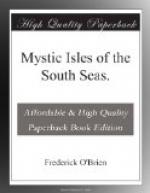Very soon I was filled with the languor of these isles. I hardly stirred from my living-place. The bustle of the monthly steamship-day died with the going of the Noa-Noa, the through passengers departing in angry mood because their anticipated hula dance had been a disappointment—wickedness shining feebly through cotton gowns when they had expected nudity in a pas seul of abandonment. There was a violent condemnation by the duped men of “unwarranted interference by the French Government with natural and national expression.”
Hogg, an American business traveler, said “The Barbary Coast in Frisco had Tahiti skinned a mile for the real thing,” and Stevens, a London broker, that the dance was “bally tame for four bob.”
Papeete, with the passing throng gone, was a quiet little town, contrasting with the hours when the streets swarmed with people from here and the suburbs, the band playing, the bars crowded, and all efforts for gaiety and coquetry and the selling of souvenirs and intoxicants. What exotic life there was beyond the clubs, the waterfront, and the Asiatic quarter revolved around the Tiare, and entirely so because of its proprietress, Lovaina. She was the best-known and best-liked woman in all these South Seas, remembered from Australia to the Paumotus, from London to China, wherever were people who had visited Tahiti, as “dear old Lovaina.”
She was very large. She was huge in every sense, weighing much more than three hundred pounds, and yet there was a singular grace in her form and her movements. Her limbs were of the girth of breadfruit-trees, and her bosom was as broad and deep as that of the great Juno of Rome, but her hands were beautiful, like a plump baby’s, with fascinating creases at the wrists, and long, tapering fingers. Her large eyes were hazel, and they were very brilliant when she was merry or excited. Her expansive face had no lines in it, and her mouth was a perfection of curves, the teeth white and even. Her hair was red-brown, curling in rich profusion, scented with the hinano-flower, adorning her charmingly poised head in careless grace.
When she said, “I glad see you,” there was a glow of amiability, an alluring light in her countenance, that drew one irresistibly to her, and her immense, shapely hand enveloped one’s own with a pressure and a warmth that were overpowering in their convincement of her good heart and illimitable generosity.
Lovaina was only one fourth Tahitian, all the remainder of her racial inheritance being American; but she was all Tahitian in her traits, her simplicity, her devotion to her friends, her catching folly as it flew, and her pride in a new possession.
One morning I got up at five o’clock and went to the bath beside the kitchen. It was a shower, and the water from the far Fautaua valley the softest, most delicious to the body, cool and balmy in the heat of the tropic. Coming and going to baths here, whites throw off easily the fear of being thought immodest, and women and men alike go to and fro in loin-cloths, pajamas, or towels. I wore the pareu, the red strip of calico, bearing designs by William Morris, which the native buys instead of his original one of tapa, the beaten cloth made from tree bark or pith.




